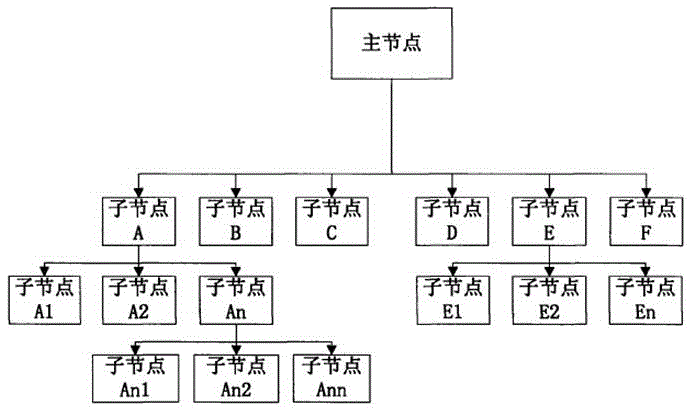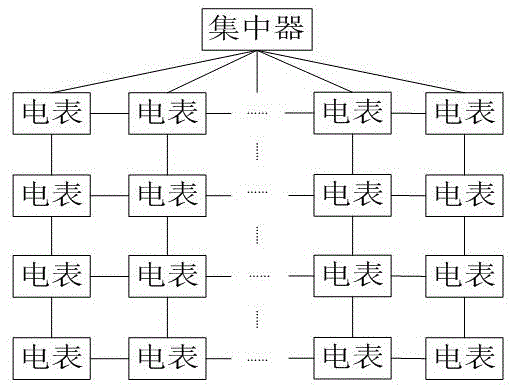A Method for Power Line Carrier Meter Reading Based on Dynamic Routing Algorithm
A technology of power line carrier and power line, which is applied in the field of electric meter data acquisition, can solve problems such as the failure of multiple data communication paths to communicate normally, and the failure of large-scale electric meter reading, so as to reduce the forwarding and meter reading of repeated request frames and repeated data frames high success rate
- Summary
- Abstract
- Description
- Claims
- Application Information
AI Technical Summary
Problems solved by technology
Method used
Image
Examples
Embodiment 1
[0043] A system structure involved in a dynamic routing algorithm for power line carrier meter reading in this embodiment, such as figure 2 As shown, it includes a concentrator and an ammeter, and the concentrator and the ammeter, and the ammeter and the ammeter are connected by power lines.
[0044] It is a dynamic routing algorithm for power line carrier meter reading, comprising the following steps:
[0045] S1: The concentrator sends a request frame to the power line in the form of broadcast to read the data of the electric meter; the specific steps are as follows:
[0046] S11: Before sending the request frame, first monitor whether the power line is in an idle state, the process is as follows:
[0047] S111: The concentrator sends a listening frame to the power line to detect whether the power line is busy;
[0048] S112: While the concentrator sends the interception frame to the power line, the concentrator receives the interception frame sent by the concentrator its...
Embodiment 2
[0080] As a further supplement to Embodiment 1, each request frame / data frame also includes the survival time of the request frame / data frame t=T-t'×repeat times, where T is when the request frame / data frame is generated The original survival time, t' is the time consumption factor, the time consumption factor t'=per frame data physical layer transmission time+program processing time, since the maximum transmission time of each frame data on the physical layer is 170ms, in order to prevent frame Frame transmission time is delayed due to frame waiting and other situations during transmission, so the physical layer transmission time of each frame is preferably slightly longer than 170ms, preferably 200ms, and the maximum processing time of the program is 40ms.
[0081] Correspondingly, in the step S4, the step of removing the repeated request frame is also included, and the process is as follows:
[0082] Each meter parses all request frames received at the same time, obtains the ...
Embodiment 3
[0092] As a further supplement to the above embodiment, the request frame includes a task ID, and the task ID represents the type of electric meter data that should be included in the data frame that the concentrator requests the target electric meter to send. The types of the electricity meter data include: voltage, current, electricity, power, load curve, frame loss record. Since the meter reading system and method based on the power line carrier has been relatively maturely applied in the prior art, there are certain criteria for the types of meter data required for meter reading and the specific format and requirements of these data. This will not be described in detail in this application.
PUM
 Login to View More
Login to View More Abstract
Description
Claims
Application Information
 Login to View More
Login to View More - R&D
- Intellectual Property
- Life Sciences
- Materials
- Tech Scout
- Unparalleled Data Quality
- Higher Quality Content
- 60% Fewer Hallucinations
Browse by: Latest US Patents, China's latest patents, Technical Efficacy Thesaurus, Application Domain, Technology Topic, Popular Technical Reports.
© 2025 PatSnap. All rights reserved.Legal|Privacy policy|Modern Slavery Act Transparency Statement|Sitemap|About US| Contact US: help@patsnap.com


